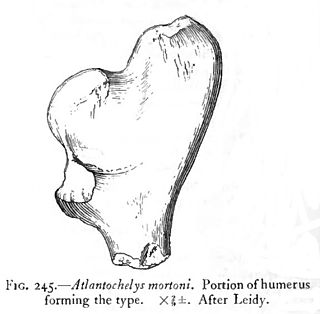 W
WAtlantochelys is an extinct genus of sea turtle from the Upper Cretaceous of New Jersey. For 163 years, only a partial humerus was known, but the second part of the same bone was found in 2012. The full size has been extrapolated as being 3 m (9.8 ft).
 W
WAttopsis is an extinct genus of ants in the formicid subfamily Formicinae. While formerly containing a number of species, the genus is currently monotypic; the type species, Attopsis longipennis, is known from a single Early Miocene fossil found in what is now Croatia.
Bombycites oeningensis is an extinct lepidopteran from the Messinian of Öhningen, Switzerland. It is described in 1849 from a fossil pupa by the Swiss geologist and naturalist Oswald Heer. Because neither the adult nor larval forms are known, either of which contain crucial diagnostic features, its familial and superfamilial placement is uncertain.
 W
WCasaleia is an extinct genus of ants in the formicid subfamily Amblyoponinae described by Pagliano & Scaramozzino in 1990 from fossils found in Europe. The genus contains four species dating from the Eocene to Miocene, Casaleia eocenica, Casaleia inversa, Casaleia longiventris, Casaleia orientalis.
 W
WChasmops is a trilobite in the order Phacopida that existed during the upper Ordovician in what is now Estonia. It was described by McCoy in 1849, and the type species is Chasmops odini, which was originally described under the genus Calymene by Eichwald in 1840. It also contains the species C. maxima.
 W
WCladophlebis is an extinct form genus of fern, used to refer to Paleozoic and Mesozoic fern leaves that have "fern fronds with pinnules that are attached to the rachis, and have a median vein that runs to the apex of the pinnule, and veins from that are curved and dichotomise". By convention this genus is not used to refer to fossil ferns from the Cenozoic. Ferns with this morphology belong to several families, including Osmundaceae, Dicksoniaceae and Schizaeaceae. Ferns with this morphology are common during the Paleozoic and Mesozoic in both the northern and southern hemispheres.
 W
WComposita is an extinct brachiopod genus that lived from the Late Devonian to the Late Permian. Composita had a cosmopolitan global distribution, having lived on every continent except Antarctica. Composita had a smooth shell with a more or less distinct fold and sulcus and a round opening for the pedicle on the pedicle valve. Composita is included in the family Athyrididae and placed in the subfamily Spirigerellinae.
 W
WEmplastus is an extinct morphogenus of ants in the subfamily Dolichoderinae, known from fossils found in Asia and Europe. The genus contains twelve species described from sites in England, Eastern Europe and Far Eastern Russia.
 W
WHoploparia is a genus of fossil lobster belonging to the family Nephropidae. The type species of this genus is Hoploparia longimana.
 W
WLiometopum imhoffii is an extinct species of ants in the dolichoderine genus Liometopum. The species was described from a number of Early Miocene fossils found in what is now Croatia.
 W
WPliopithecus is a genus of extinct primates of the Miocene. It was discovered in 1837 by Édouard Lartet (1801–1871) in France, with fossils subsequently discovered in Switzerland, Slovakia and Spain.
 W
WPropalaeotherium was an early genus of equid endemic to Europe and Asia during the Early Eocene.
 W
WTriodus is an extinct genus of xenacanthidan shark that lived from the Carboniferous to the Triassic. It was a freshwater shark, and fossils have been found in the Chinle Formation and Black Prince Limestone of Arizona, the Petrified Forest Member of New Mexico and the Tecovas Formation of Texas, United States. In 2017, a new species Triodus richterae was described from the Rio do Rasto Formation of Brazil.